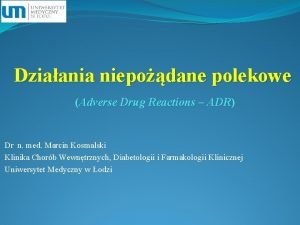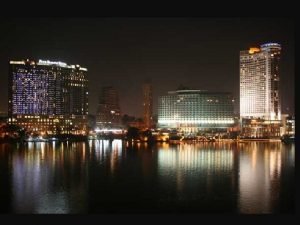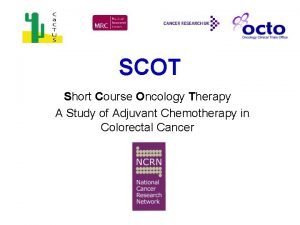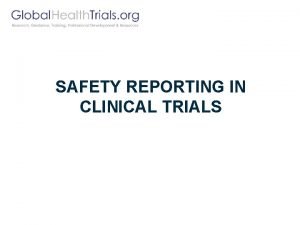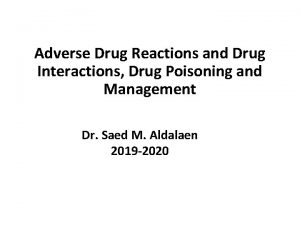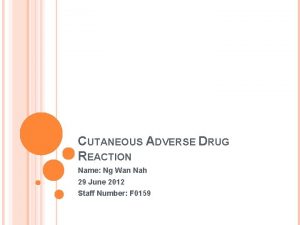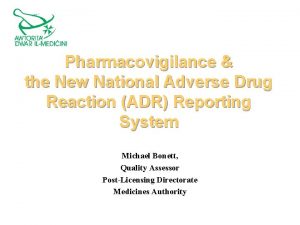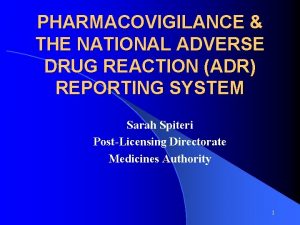ADVERSE DRUG REACTION Dr Syed Ayaz Ali M







- Slides: 7

ADVERSE DRUG REACTION Dr. Syed Ayaz Ali M. Pharm; Ph. D Associate Professor & Head Dept. of Pharmacology Y. B. Chavan College of Pharmacy Aurangabad

ADVERSE DRUG REACTIONS Drug Administered Undesired Effects Desired Effects Clinically beneficial action Innocuous (Not Harmful) Harmful Or ADR or Untoward reaction

Factors Responsible for ADR’s • Drug Explosion- Potent drugs- ADR is appreciable • Physician – drug induced diseases (Iatrogenic diseases) • Increased availability of potent drugs • Dangerous drugs without prescription • Environmental & Occupational exposure of Chemicals, drugs to Humans • Polypharmacy • Self medication Side effect: It is restricted to therapeutically undesirable but unavoidable effects of drugs , even when they are used in their therapeutic doses. Examples: Anorexia, Cramps, Mild diarrhea, headache, nausea etc.

Adverse drug reactions : An adverse drug reaction is any response to a drug which is noxious (injurious) and unintended and which occurs at doses used in man for prophylaxis, diagnosis or therapy of disease. Major Adverse drug reactions can involve many organs and include addiction, allergic reactions, shock, CHF, Paralysis, coma, convulsions, diabetes mellitus, neoplasia, anaphylactic shock etc. ADR’s require treatment or decrease in dosage or stoppage of therapy. Adverse drug reactions can be logically separated into two types.

Type A ADR’s Type B ADR’s 1. Normal 1. Totally Abnormal 2. Augmented Pharmacological actions 2. Not expected 3. In Therapeutic doses 4. E. g. Bradycardia with Beta blockers of 4. E. g. Malignant hyperthermia anesthetic & Immune reactions. 5. Predictable 5. Unpredictable 6. Dose dependent 6. Not observed during conventional toxicological screening. 7. Incidence & morbidity is high 7. Incidence & morbidity is low 8. Mortality is high.

Classification of ADR’s Adverse drug reactions may be classified as under 1. Pharmacologic ADR’s A. Extension of therapeutic effect B. Nontherapeutic adverse effect 2. Non Pharmacologic ADR’s A. Hypersensitivity (Drug Allergy) B. Idiosyncrasy (Pharmacogenetics) C. Photosensitivity 3. Disease related ADR’s 4. Multiple Drug Reactions 5. Miscellaneous ADR’s A. Carcinogenicity B. Teratogenicity (Dysmorphogenesis) C. Drug Dependence D. Overdosage (Relative & Absolute) E. Drug-induced sexual dysfunctions

Drugs acting on Cholinergic Nervous System Category Class Prominent ADR’s Parasympathomimetics Cholinomimetic Choline esters Generalized cholinergic stimulation, sweating, salivation, flushing, fall in B. P, abdominal pain, diarrhea, bronchospasm Natural alkaloids CNS disturbances, profuse sweating & salivation Anticholinestrase (Reversible) Physostigmine Convulsions, bradycardia, paralysis of skeletal muscles Neostigmine Generalized cholinergic stimulation, sweating, salivation, flushing, fall in B. P, abdominal pain, diarrhea, bronchospasm Natural alkaloids Atropine Xerostomia, hallucination, delirium, dryness of mouth, dry skim, increase in body temp, blurred vision, photophobia, urinary retention, palpitation & tachycardia and constipation. Parasympatholytics
